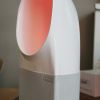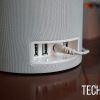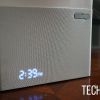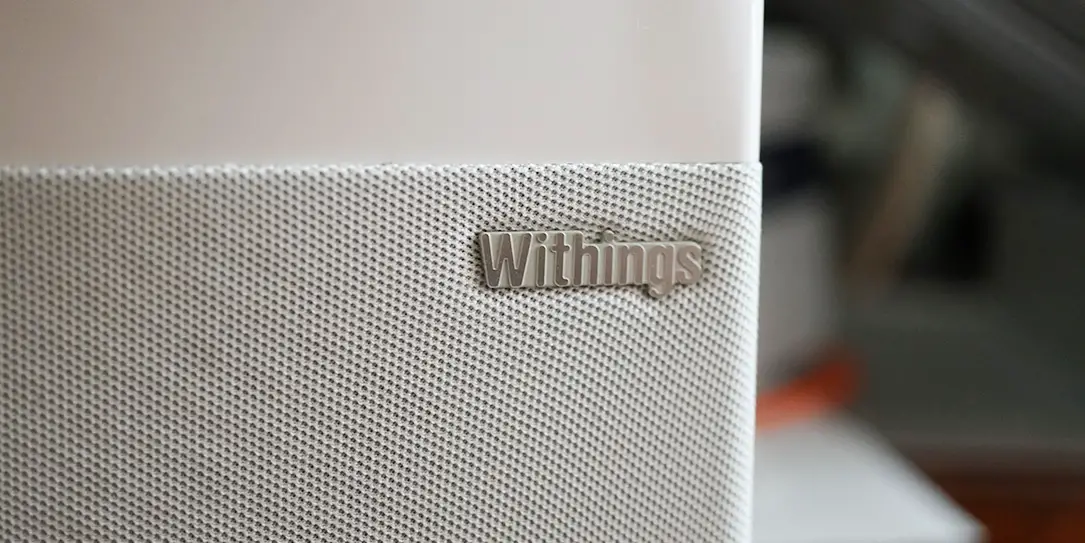For years I have used my smartphone as my primary alarm clock and occasional sound machine. The combination of the built in alarm clock and an app called White Noise Pro was all I used. So when Withings offered to send me their Aura connected alarm clock, I decided why not? Let’s give it a go and see what this is all about. Read on for the full Withings Aura review.
Design
The Aura is sporting some futuristic i, ROBOT looks here with its white chassis and curved lines. This device is certainly not going to be everyone’s cup of tea, but I found it to be an elegant soft look. The front of the Aura is where the large light opening is located, and there’s a small LED at the bottom which projects up and fills the opening with ambient lighting. The front is where the speaker is also located along with the clock display and Withings branding.
The Aura relies on a touch control interface, and both of the touch surfaces are located on the top and right of the device. These areas allow you to snooze alarms, turn programs on and off, raise and lower lighting, and sound. Around the back you have 3 USB ports for charging your smartphones and tablets and a power connector for powering the Aura. The device is made of mostly plastics, but it’s solid with no signs of poor craftsmanship. Overall, the design and build quality of the Aura is really nice. Not everyone may like it, though, as it really does take some getting used to.
Software/Ecosystem
The Aura is controlled by the Withings Healthmate app which can be found in the App Store and Google Play Store. The Healthmate app is kind of a hub for several different Withings products. You’ll just have to add the Aura to your devices list at initial setup of the device. The app allows you to set a sleep program. You can set the ambient lighting and sound machine settings in the app as well as the clock brightness and alarms.
The app also allows you to choose how you want to wake up. You can choose some built in alarm sounds or Withings internet radio stations and Spotify. Spotify is the only streaming music service that works with the Aura, and that’s a disappointment as I use Apple Music for streaming. The radio station choices are plentiful but nothing really caught my eye so I stuck with a preset alarm clock sound. Probably the best part of the way Aura does its alarms is the progressive method used to wake you up. Rather than a blaring alarm sounding off you can set a cycle for waking up.
For example, I have my alarm set for 4:45am M-F and the Aura starts its alarm cycle around 4:25am. At 4:25am the Aura slowly turns on its ambient blue light and slowly raises the volume on the alarm for the next 20 minutes. Most of the time I wake up between 4:35am and 4:40am because I can hear the soft sound of the alarm growing louder, and the soft blue light doesn’t blind me. It’s a pleasant way to wake up and you can set it to your liking which gives it a lot of versatility.
You can also set the sound machine portion of the sleep program. My sleep program turns on with red ambient lighting and the sound of rain and thunderstorms. As the cycle plays through, the red lighting slowly softens and the sound slowly fades out. Most of the time I’m long asleep before I even notice the light and sound have stopped. All of these parameters are adjustable within the app. The app also tracks your sleep patterns, and the sensors on the Aura detect the temperature and sound levels in the room which could help you understand if they were affecting your sleep. The app also serves as a movement and weight tracker, should you choose to use those features.
Withings also offers sleep sensors which can be plugged in the USB ports on the back and placed under your mattress, for deeper sleep tracking. These cost extra and did not come with our review sample, so we could not test any of those features. The sleep sensor is supposed to track your movement in bed at night. The Aura does have some motion sensors but the bed sensor is supposed to be more accurate.
Ease of Use
Using the Aura is pretty simple, once you have things set up within the app it’s just a matter of getting to know what you are going to like. Even the gesture touch controls are simple. Placing your hand on the right touch pad (not visible but under the plastic) for 3 seconds you can activate and deactivate alarms. Swiping up or down on the same right touch pad adjusts the light and volume up and down. The top touch pad is for activating a program (long touch for 3 seconds), snoozing alarms (single touch/tap) and turning off a program (double touch/tap). Overall once you get to know the device and the app you shouldn’t have any issues operating.
Performance
The Aura performed exactly as it is advertised and I had no problems with setup and use of the device. Thus far it has been consistent and Bluetooth connectivity is solid.
Price/Value
This can get pricey for some but I feel it’s a better alternative to using your smartphone for the same purpose and I love the ambient light feature of the Aura.
Wrap Up
As an alarm clock, sound machine and ambient light device I really enjoyed using the Aura. I’ve always been one to need soothing sounds at night to help me sleep. Years before all this tech I always used a fan for that purpose (I actually still do…old habits die hard). While you can use apps on your smartphone to get your alarm and even a sound machine, I like the Aura for its ambient light and sleep programs that ease you into and out of sleep. No this isn’t for everyone, but if you’re like me and are sensitive/dependent on light and sound for a good night’s rest, the Aura might be a good investment.
[rwp-review id=”0″]*We were sent a sample of the Withings Aura for the purposes of this review.
Last Updated on January 23, 2017.
















